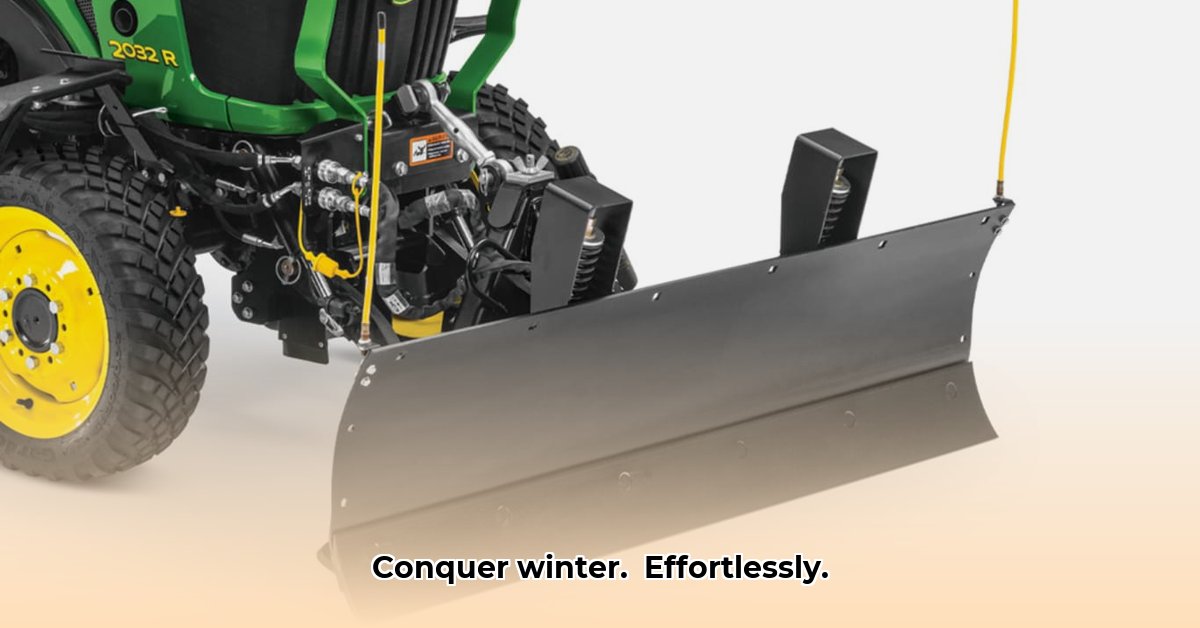
Understanding Your John Deere Compact Tractor Snow Blade
Conquering winter's snowy onslaught just got easier. A John Deere compact tractor snow blade isn't just for clearing driveways; it's about reclaiming control over your winter. This guide helps you maximize its power and efficiency, turning a chore into a manageable task. We'll cover setup, operation, maintenance, and safety, ensuring you're ready for whatever winter throws your way. Did you know that using a snow blade efficiently can significantly reduce your fuel consumption? This translates to both cost savings and a reduced environmental footprint. For more detailed snow removal tips, check out this helpful guide.
Technical Specifications
Exact specifications vary by model; consult your owner's manual for precise details. However, here's a general overview:
| Specification | Typical Range | Notes |
|---|---|---|
| Blade Width | 60-84 inches | Wider blades cover more ground but may require more tractor power. |
| Blade Height | 20-30 inches | Taller blades handle deeper snow but can be less maneuverable in tight spaces. |
| Weight | 300-600 lbs | Heavier blades are more robust but may put more strain on your tractor. |
| Hydraulic Lift Capacity | Varies depending on tractor model and pump | Check your tractor's specifications to ensure compatibility. |
Assembly and Installation: The Quik-Tatch Advantage
John Deere's Quik-Tatch system simplifies attachment. Always consult your tractor's manual for model-specific instructions.
Step 1: Safety First! Ensure the tractor is off and the hydraulic system is disengaged.
Step 2: Alignment: Align the Quik-Tatch pins on the blade with the tractor's attachment points.
Step 3: Secure Connection: Insert and firmly seat the pins. A loose connection is dangerous and ineffective.
Step 4: Hydraulics: Connect the hydraulic hoses, avoiding kinks. Check for leaks.
Step 5: Test Lift: Raise and lower the blade to verify hydraulic function.
Operational Instructions: Effective Snow Removal
Safe and efficient snow removal relies on understanding your equipment.
Blade Angle Adjustment: Fine-tune the blade angle for optimal snow dispersal. Experiment to find what works best.
Snow Types: Adjust your speed and blade angle for different snow types (light, fluffy vs. heavy, wet).
Speed Control: Slower speeds are safer and more effective. Avoid excessive speed.
Visibility: Maintain clear visibility at all times, especially crucial at night.
Maintenance and Troubleshooting: Prolonging Equipment Life
Preventative maintenance is crucial for longevity and smooth operation.
Lubrication: Keep moving parts well-lubricated using the recommended lubricants (specified in your owner's manual).
Regular Inspections: Inspect for wear, tear, or damage. Early detection prevents major issues.
Blade Sharpening: A sharp blade is more efficient. Consider regular sharpening to enhance performance.
Troubleshooting: Consult your owner's manual for common problems. Contact John Deere support if needed.
Safety Precautions: Prioritizing Your Well-being
Safety is paramount.
Protective Gear: Always wear eye protection and sturdy gloves.
Awareness: Be aware of your surroundings, avoiding obstacles and maintaining a safe distance from bystanders.
Equipment Knowledge: Understand your tractor's and snow blade's limitations.
Emergency Plan: Know your emergency stop procedures.
Sustainability Considerations: Minimizing Environmental Impact
Efficient snow removal minimizes fuel consumption, reducing your carbon footprint. Proper maintenance extends equipment lifespan, reducing the need for replacements and associated resource consumption. This aligns with John Deere's commitment to sustainable agriculture, as highlighted in their 2022 Sustainability Report.
Conclusion
This guide provides a general overview. Always refer to your owner's manual for model-specific instructions. Contact John Deere for additional assistance or information. Remember, mastering your John Deere compact tractor snow blade not only improves winter efficiency but also contributes to a more sustainable future.